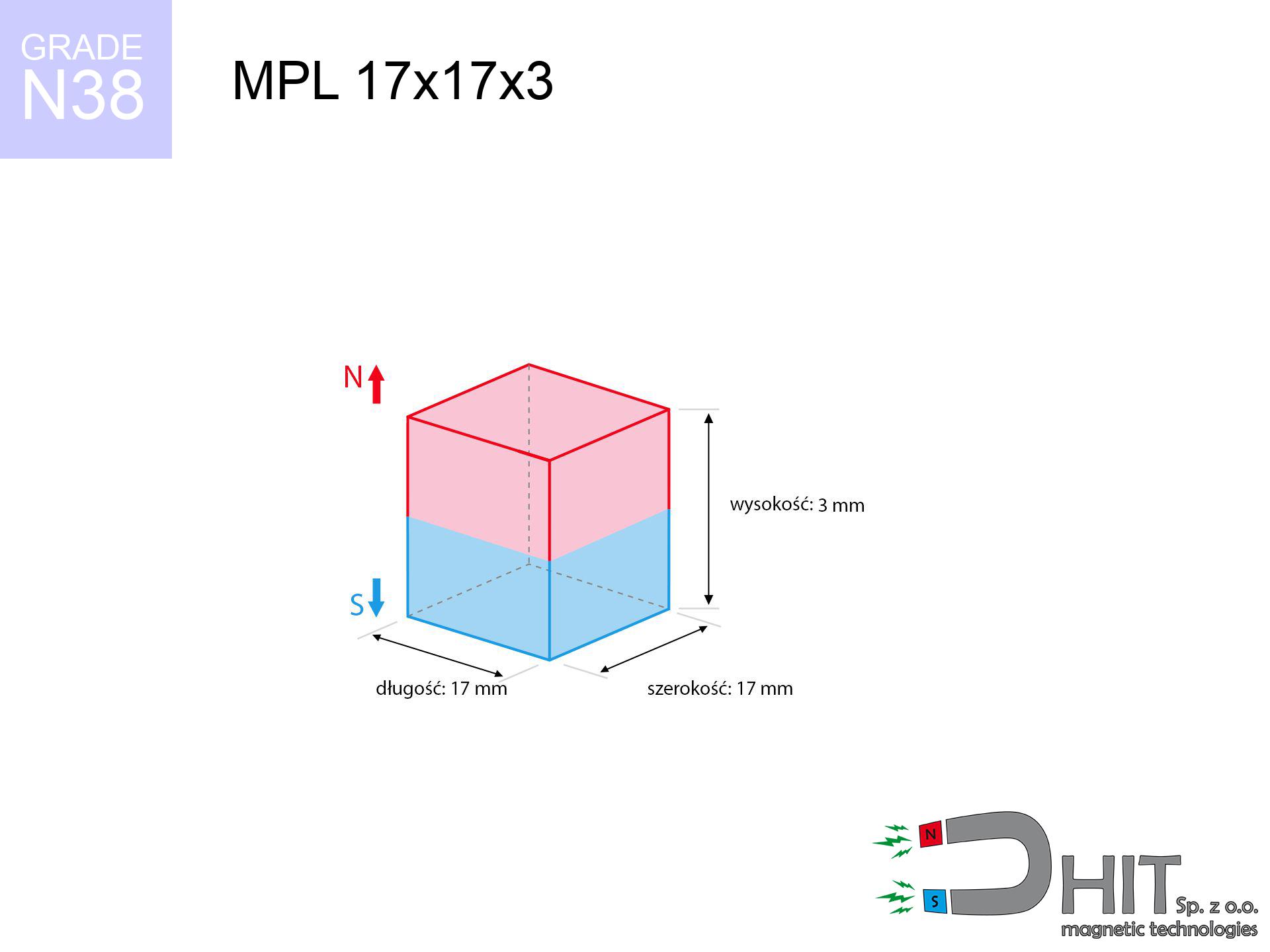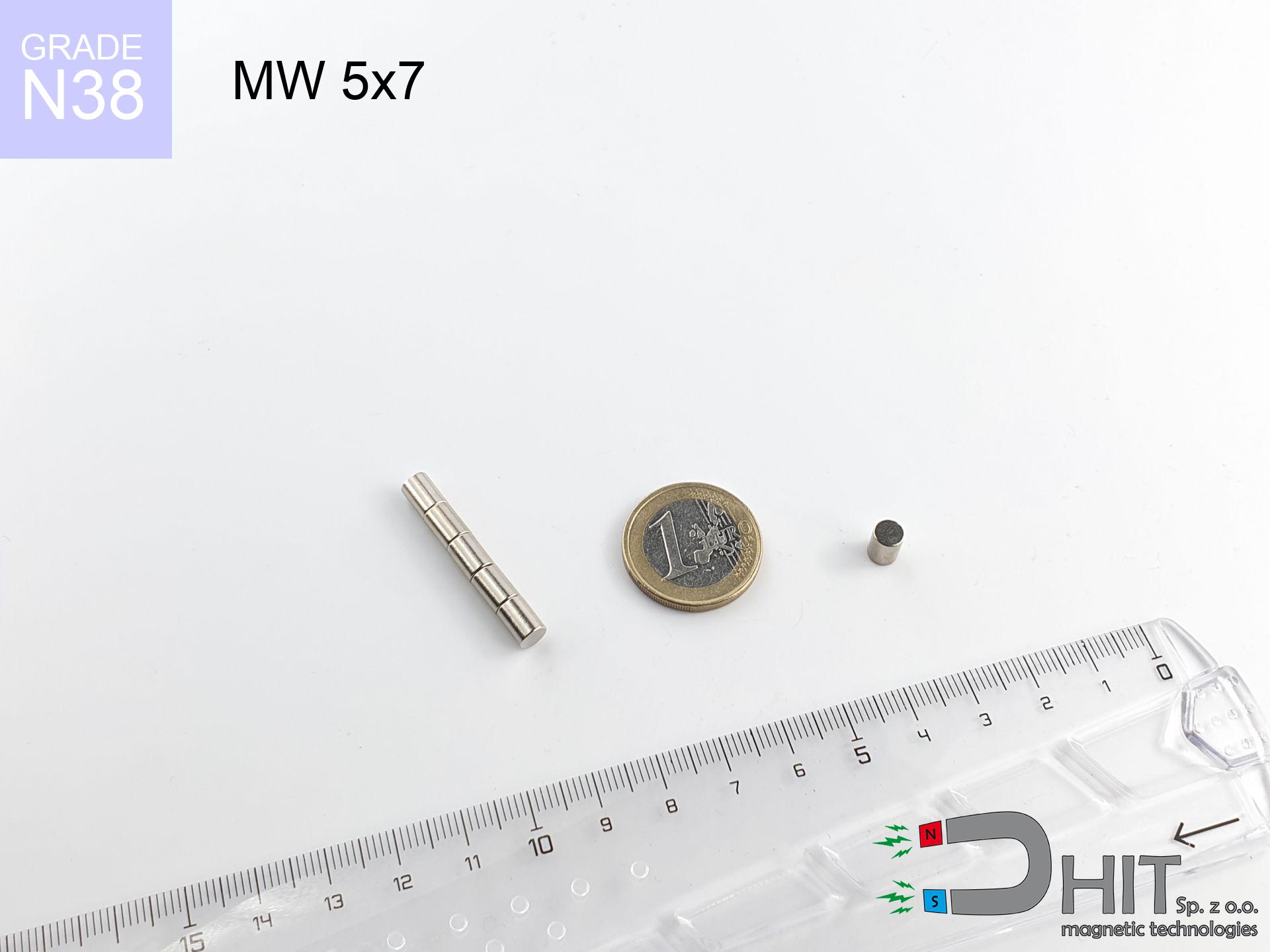MPL 17x17x3 / N38 - lamellar magnet
lamellar magnet
Catalog no 020124
GTIN: 5906301811305
length [±0,1 mm]
17 mm
Width [±0,1 mm]
17 mm
Height [±0,1 mm]
3 mm
Weight
6.5 g
Magnetization Direction
↑ axial
Load capacity
4.03 kg / 39.52 N
Magnetic Induction
187.48 mT
Coating
[NiCuNi] nickel
4.71 ZŁ with VAT / pcs + price for transport
3.83 ZŁ net + 23% VAT / pcs
bulk discounts:
Need more?Not sure about your choice?
Call us now
+48 22 499 98 98
alternatively get in touch via
request form
the contact section.
Strength and shape of neodymium magnets can be calculated using our
our magnetic calculator.
Order by 14:00 and we’ll ship today!
MPL 17x17x3 / N38 - lamellar magnet
Magnetic properties of material N38
Physical properties of NdFeB
Shopping tips
Advantages and disadvantages of neodymium magnets NdFeB.
In addition to their immense magnetic power, neodymium magnets offer the following advantages:
- Their power is durable, and after around ten years, it drops only by ~1% (according to research),
- They show superior resistance to demagnetization from outside magnetic sources,
- The use of a mirror-like gold surface provides a refined finish,
- They exhibit extremely high levels of magnetic induction near the outer area of the magnet,
- With the right combination of magnetic alloys, they reach excellent thermal stability, enabling operation at or above 230°C (depending on the form),
- With the option for customized forming and targeted design, these magnets can be produced in various shapes and sizes, greatly improving application potential,
- Key role in cutting-edge sectors – they find application in HDDs, rotating machines, healthcare devices as well as high-tech tools,
- Thanks to their efficiency per volume, small magnets offer high magnetic performance, while occupying minimal space,
Disadvantages of NdFeB magnets:
- They are prone to breaking when subjected to a sudden impact. If the magnets are exposed to shocks, it is suggested to place them in a steel housing. The steel housing, in the form of a holder, protects the magnet from cracks and increases its overall resistance,
- They lose strength at high temperatures. Most neodymium magnets experience permanent loss in strength when heated above 80°C (depending on the geometry and height). However, we offer special variants with high temperature resistance that can operate up to 230°C or higher,
- They rust in a moist environment, especially when used outside, we recommend using sealed magnets, such as those made of rubber,
- Using a cover – such as a magnetic holder – is advised due to the restrictions in manufacturing holes directly in the magnet,
- Health risk from tiny pieces may arise, when consumed by mistake, which is notable in the family environments. Furthermore, tiny components from these magnets can interfere with diagnostics when ingested,
- Higher purchase price is an important factor to consider compared to ceramic magnets, especially in budget-sensitive applications
Highest magnetic holding force – what contributes to it?
The given lifting capacity of the magnet means the maximum lifting force, measured in ideal conditions, that is:
- with mild steel, used as a magnetic flux conductor
- of a thickness of at least 10 mm
- with a polished side
- with no separation
- under perpendicular detachment force
- in normal thermal conditions
What influences lifting capacity in practice
The lifting capacity of a magnet depends on in practice key elements, from primary to secondary:
- Air gap between the magnet and the plate, since even a very small distance (e.g. 0.5 mm) can cause a drop in lifting force of up to 50%.
- Direction of applied force, because the maximum lifting capacity is achieved under perpendicular application. The force required to slide the magnet along the plate is usually several times lower.
- Thickness of the plate, as a plate that is too thin causes part of the magnetic flux not to be used and to remain wasted in the air.
- Material of the plate, because higher carbon content lowers holding force, while higher iron content increases it. The best choice is steel with high magnetic permeability and high saturation induction.
- Surface of the plate, because the more smooth and polished it is, the better the contact and consequently the greater the magnetic saturation.
- Operating temperature, since all permanent magnets have a negative temperature coefficient. This means that at high temperatures they are weaker, while at sub-zero temperatures they become slightly stronger.
* Holding force was checked on the plate surface of 20 mm thickness, when the force acted perpendicularly, however under attempts to slide the magnet the lifting capacity is smaller. In addition, even a slight gap {between} the magnet’s surface and the plate reduces the load capacity.
Be Cautious with Neodymium Magnets
Under no circumstances should neodymium magnets be placed near a computer HDD, TV, and wallet.
The strong magnetic field generated by neodymium magnets can destroy magnetic media such as floppy disks, video tapes, HDDs, credit cards, magnetic ID cards, cassette tapes, etc. devices. They can also destroy devices like video players, televisions, CRT computer monitors. Remember not to place neodymium magnets close to these electronic devices.
Neodymium magnets can become demagnetized at high temperatures.
Although magnets are generally resilient, their ability to retain their magnetic strength can be influenced by factors like the type of material used, the magnet's shape, and the intended purpose for which it is employed.
Neodymium magnetic are highly delicate, they easily break as well as can crumble.
Neodymium magnets are characterized by significant fragility. Neodymium magnets are made of metal and coated with a shiny nickel, but they are not as durable as steel. In the event of a collision between two magnets, there may be a scattering of fragments in different directions. Protecting your eyes is crucial in such a situation.
Comparing neodymium magnets to ferrite magnets (found in speakers), they are 10 times more powerful, and their power can surprise you.
Read the information on our website on how to properly utilize neodymium magnets and avoid significant harm to your body and unintentional disruption to the magnets.
Do not give neodymium magnets to children.
Neodymium magnets are not toys. You cannot allow them to become toys for children. In such a situation, surgery is necessary to remove them. In the worst case scenario, it can result in death.
Dust and powder from neodymium magnets are flammable.
Do not attempt to drill into neodymium magnets. Mechanical processing is also not recommended. If the magnet is crushed into fine powder or dust, it becomes highly flammable.
Neodymium magnets are not recommended for people with pacemakers.
In the case of neodymium magnets, there is a strong magnetic field. As a result, it interferes with the operation of a heart pacemaker. Even if the magnetic field does not affect the device, it can damage its components or deactivate the entire device.
It is crucial not to allow the magnets to pinch together uncontrollably or place your fingers in their path as they attract to each other.
Neodymium magnets bounce and also touch each other mutually within a radius of several to almost 10 cm from each other.
Avoid bringing neodymium magnets close to a phone or GPS.
Magnetic fields interfere with compasses and magnetometers used in navigation for air and sea transport, as well as internal compasses of smartphones and GPS devices.
The magnet coating is made of nickel, so be cautious if you have an allergy.
Studies show a small percentage of people have allergies to certain metals, including nickel. An allergic reaction often manifests as skin redness and rash. If you have a nickel allergy, try wearing gloves or avoid direct contact with nickel-plated neodymium magnets.
Safety rules!
Please read the article - What danger lies in neodymium magnets? You will learn how to handle them properly.





![SM 25x275 [2xM8] / N42 - magnetic separator SM 25x275 [2xM8] / N42 - magnetic separator](https://cdn3.dhit.pl/graphics/products/sm-25x275-2xm8-boc.jpg)
![SM 32x275 [2xM8] / N52 - magnetic separator SM 32x275 [2xM8] / N52 - magnetic separator](https://cdn3.dhit.pl/graphics/products/sm-32x275-2xm8-get.jpg)


